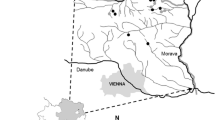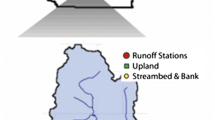Abstract
Concentrations of soluble reactive phosphorus (SRP), nitrate, and soluble reactive silicon (SRSi) were monitored in 12 streams draining small catchments (<10 km2) in the English Lake District. The catchments varied with respect to underlying geology, soil type and land cover. Average concentrations of SRP were in the range 0.5–11.2 μg P l-1, and estimated loads ranged from 0.01 to 0.14 kg P ha-1 a-1. The higher concentrations and loads were associated with catchments containing improved pasture. Mean streamwater concentrations of nitrate varied from 55 to 660 μg N l-1, while loads were in the range 0.8–9.6 kg N ha-1 a-1; no general dependence on catchment properties was discerned. Concentrations of SRSi were similar in all the streams (0.8–2 mg Si l-1), and annual loads were in the range 10–26 kg Si ha-1 a-1. Loads of all three nutrients were greatest during the winter, because of higher discharges, but in some catchments containing improved pasture, considerable transport of P also took place during the summer. Concentrations of nitrate in streams draining unimproved moorland catchments are approximately twice those reported for samples taken from similar streams in 1973 and 1974, possibly because of increased atmospheric deposition of inorganic nitrogen (ammonium and nitrate). Concentrations of SRP in such streams were similar to those reported for the earlier samples. Comparisons of stream loads of SRP and nitrate with estimated inputs suggest that catchment soils retain substantial amounts of these nutrients. Implications for surface water eutrophication of changes in P retention by soils are discussed.
Similar content being viewed by others
References
Ahl, T., 1988. Background yield of phosphorus from drainage area and atmosphere: an empirical approach. Hydrobiologia 170: 35–44.
Allen, S. E., A. Carlisle, E. J. White & C. C. Evans, 1968. The plant nutrient content of rainwater. J. Ecol. 56: 497–504.
Burnhill, P., A. Chalmers, & J. Fairgrieve, 1996. The British Survey of Fertiliser practice. Fertiliser Use on Farm Crops for Crop Year 1995. HMSO, London.
Carrick, T. R. & D. W. Sutcliffe, 1983. Concentrations of major ions in streams on catchments of the River Duddon (1971–1974) and Windermere (1975–1978), English Lake District, Freshwater Biological Association (U.K.) Occ. Publ. No. 21.
Davison, W., D. G. George & N. J. A. Edwards, 1995. Controlled reversal of lake acidification by treatment with phosphate fertiliser. Nature (London) 377: 504–507.
Gibson, C. E., Y. Wu, & D. Pinkerton, 1995. Substance budgets of an upland catchment: the significance of atmospheric phosphorus. Freshwat. Biol. 33: 385–392.
Harper, D., 1992. Eutrophication of Freshwaters. Chapman & Hall, London.
Harrison, A. F., 1984. Effects of environment and management on phosphorus cycling in terrestrial ecosystems. J. Environ. Mgmn. 20: 163–179.
Holtan H., L. Kamp-Nielsen, A. O. Stuanes, 1988. Phosphorus in soil, water and sediment: an overview. Hydrobiologia 170, 19–34.
House, W. A., D. Leach, M. S. Warwick, B. A. Whitton, S. N. Pattinson, G. Ryland, A. Pinder, J. Ingram, J. P. Lishman, S. M. Smith, E. Rigg & F. H. Denison, 1997. Nutrient transport in the Humber rivers. Sci. Tot. Environ. 194/195: 303–320.
Jarvis, R. A., V. C. Bendelow, R. I. Bradley, D. M. Carroll, R. R. Furness, I. N. L. Kilgour & S. J. King, 1984. Soils and Their Use in Northern England. Soil Survey of England and Wales Bulletin No. 10, Harpenden.
Lund, J. W. G., 1978. Changes in the phytoplankton of an English lake, 1945–1977. Hydrobiol. J. 14: 6–21.
Manley, G., 1989. Climate. In The Lake District (W.H. Pearsall & W. Pennington). Collins, London: 106–120.
May, L., C. J. Place, & D. G. George, 1995. The development of a GIS-based catchment model to assess the effects of changes in land use on water quality. Institute of Freshwater Ecology Report to the National Rivers Authority, North-West Region.
May, L., C. J. Place & D. G. George, 1996. An assessment of the nutrient loadings from the catchment to Bassenthwaite Lake. IFE Report to Environment Agency, NW Region.
McColl, R. H. S., 1974. Self-purification of small freshwater streams: phosphate, nitrate and ammonia removal. New Zealand J. mar. Freshwat. Res. 8: 375–388.
Melack, J. M., 1995. Transport and transformations of P, fluvial and lacustrine ecosystems. In Tiessen H. (ed.), Phosphorus in the Global Environment; Transfers, Cycles and Management, Wiley, Chichester: 245–254.
Moseley, F., 1978. The Geology of the Lake District. Yorkshire Geological Society Occ. Pub. No. 3, Leeds.
Mullin, J. B. & J. P. Riley, 1955. The colorimetric determination of silicate with special reference to sea and natural waters. Analyt. chim. Acta 12: 162–176.
Murphy, J. & J. P. Riley, 1962. A modified single solution method for the determination of phosphate in natural waters. Analyt. chim. Acta 27: 31–36.
Reckhow, K. H. & J. T. Simpson, 1980. A procedure based on modeling and error analysis for the prediction of lake phosphorus concentration from land use information. Can. J. Fish. aquat. Sci. 37: 1439–1448.
Reynolds, C. S., 1978. Phosphorus and the eutrophication of lakes - a personal view. In Phosphorus in the Environment: Its Chemistry and Biochemistry. Ciba Foundation Symposium 57. Elsevier, Amsterdam, 201–216.
Sutcliffe, D. W., T. R. Carrick, J. Heron, E. Rigg, J. F. Talling, C. Woof & J. W. G. Lund, 1982. Long-term and seasonal changes in the chemical composition of precipitation and surface waters of lakes and tarns in the English Lake District. Freshwat. Biol. 3: 335–362.
Tipping, E., 1990. A model of surface water acidification in Cumbria and its uses in long-term research. Freshwat. Biol. 23: 7–23.
Tipping, E., 1996. CHUM - a hydrochemical model for upland catchments. J. Hydrol. 174: 305–330.
Tipping E., J. Hilton & J. B. James, 1988. Disssolved organic matter in Cumbrian lakes and streams. Freshwat. Biol. 19: 371–378.
Unsworth, M. H. & A. Crossley, 1987. Consequences of cloud water deposition on vegetation at high elevation. In Hutchinson T. C. & K. M. Meema (eds), Effects of Atmospheric Pollutants on Forests, Wetlands and Agricultural Ecosystems, Springer-Verlag, Berlin: 171–188.
Walling, D. E. & B. W. Webb, 1985. Estimating the discharge of contaminants to coastal waters by rivers: some cautionary comments. Mar. Poll. Bull. 16: 488–492.
Rights and permissions
About this article
Cite this article
Lawlor, A.J., Rigg, E., May, L. et al. Dissolved nutrient concentrations and loads in some upland streams of the English Lake District. Hydrobiologia 377, 85–93 (1998). https://doi.org/10.1023/A:1003215005982
Issue Date:
DOI: https://doi.org/10.1023/A:1003215005982




